Revision Notes on Plant Kingdom for NEET 2024 - Free PDF Download
The Plant Kingdom is one of the fascinating topics in Biology Class 11. The chapter covers the complete brief of the plant kingdom, along with examples and features of each component. This chapter can be a bit challenging to study on your own because there are flow charts and other pointers that need to be kept in mind. It also covers a variety of intriguing and important topics that are required for the NEET exam. You can find Plant Kingdom Class 11 notes in PDF format in this article to make the learning process easy.
Note: 👉Get a Head Start on Your Medical Career with the NEET Rank and College Predictor 2024.
You can get these Plant Kingdom notes for NEET for free download, created by Vedantu's subject matter expert. The chapter is finely defined in a simpler format that allows students to understand it well.
Plant Kingdom NEET Notes 2024
Access NEET Revision Notes Biology Plant Kingdom
Multiple attempts have been made to classify organisms. Aristotle categorised plants like herbs, shrubs, or trees over 2000 years ago.
Various Types of Classification systems:
Artificial System of Classification: This system of classification is based on morphological characters. Linnaeus categorised plants depending on the structure and number of stamens present in the flowers, which is an example of an artificial system.
Natural System of Classification: These systems are defined by morphological and anatomical characteristics including cellular ultrastructure, phytochemistry, embryology, and so on.
For example, Bentham and Hooker's classification in which they divided plants into Phanerogamia and Cryptogamia based on the presence or absence of flowers and seeds.
Phylogenetic System of Classification: It is based on the plant's evolutionary and genetic relationships, such as Whittaker, Eichler, Engler, and Prantl, and others.
Classification of Plant Kingdom:
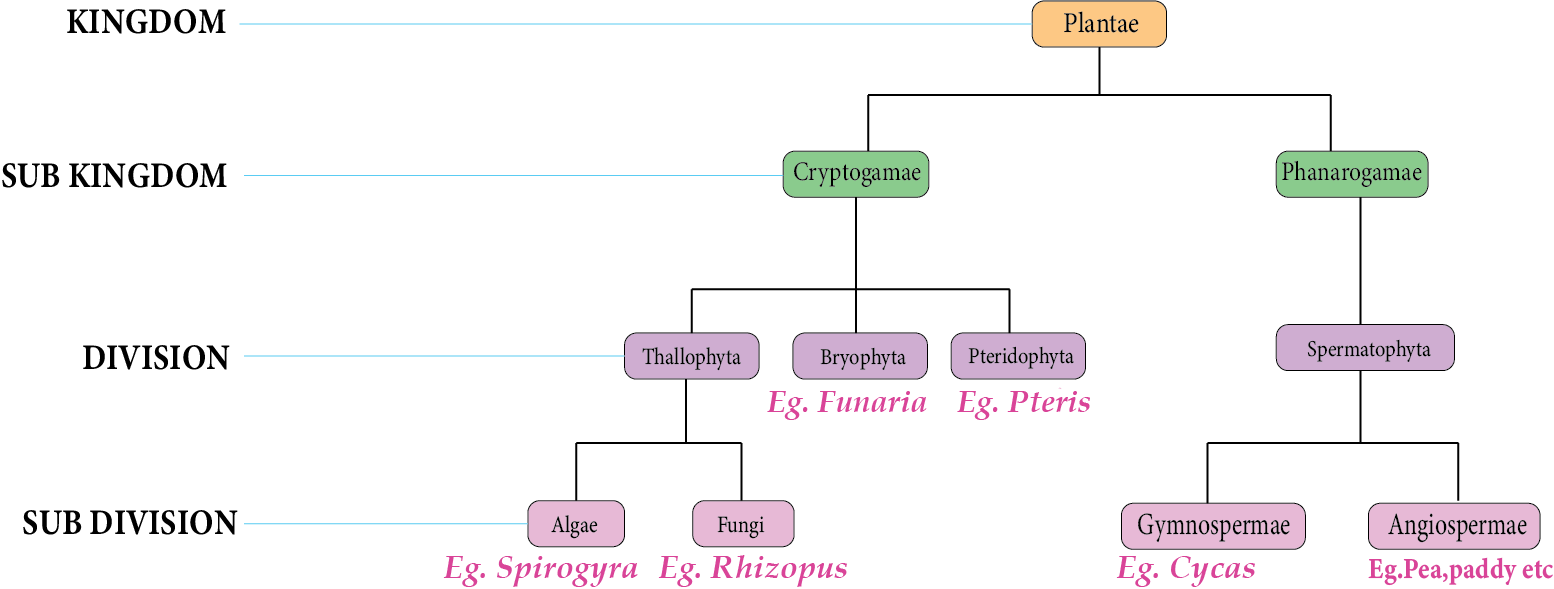
Classification of Kingdom Plantae
The plant kingdom is majorly categorised into two groups Cyptogamae and Phenarogamae.
Cyptogamae includes plants that reproduce by forming spores and do not produce flowers or seeds.
However, the Phenarogamae group includes plants possessing reproductive parts like flowers and seeds.
The plant bodies of Cryptogamae are classified into three groups: Thallophyta, Bryophyta, and Pteridophyta.
Thallophyta: In this group, the plant body is shaped like a thallus which means undifferentiated plant body. It is further divided into Algae and Fungi.
Algae are pigmented thallophytes.
But Fungi are non-pigmented thallophytes.
Bryophyta: It includes plants with a root-like organ and a stem-like organ, but no vascular tissues.
Pteridophyta: The plant body is made up of the true root, stem, and leaves. Vascular cryptogams contain vascular tissues.
Phenarogamae is classified into two groups: Gymnosperms and Angiosperms.
Gymnosperms: These are the plants possessing naked seeds.
Angiosperms: These plants reproduce by producing flowers and possessing seeds enclosed in the seed coats. Angiosperms are further divided into Dicots and Monocots.
Dicots are plants possessing seeds having two cotyledons.
Monocots are plants having seeds with only one cotyledon.
Algae:
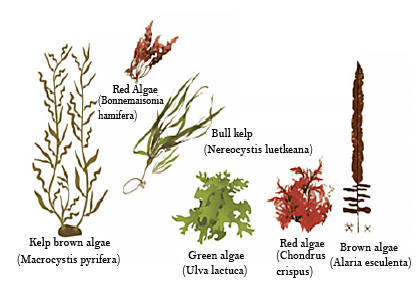
Types of Green algae
Algae are the simplest, chlorophyll-containing, thalloid, photosynthetic, autotrophic, aquatic lifeforms found in both freshwater and seawater.
They can be found in a variety of habitats, such as soils, damp stones, soils, and wood.
They exhibit three types of reproduction: vegetative, asexual, and sexual.
Asexual reproduction is accomplished through the production of spores, most popularly zoospores.
In vegetative reproduction, fragmentation is used.
Sexual reproduction occurs when two gametes fuse. The mode of sexual reproduction can be isogamous, anisogamous, and oogamous.
The fusing gametes can have flagella and the same size, like in Ulothrix, or non-flagellated but of equal size like in Spirogyra. This type of reproduction is referred to as isogamous reproduction.
In anisogamous reproduction, both the fusing gametes are of unequal size. For example, Chlamydomonas.
However, in the oogamous case, the male gamete is very small and motile but the female gamete is comparatively very large and non-motile. For example, Nostoc, Volvox.
The three different types of algae are Chlorophyceae, Phaeophyceae, and Rhodophyceae.
Chlorophyceae:
Chlorophyceae is another name for green algae.
They are popularly grass green since chlorophyll a and b pigments predominate in them.
Most members' chloroplasts contain one or more pyrenoids, which contain more protein than carbohydrates.
Green algae have a tough cell wall that is made up of an inner cellulose sheet and an outer pectose layer.
Asexual reproduction occurs through the formation of flagellated zoospores in zoosporangia.
But, in green algae, sexual reproduction occurs through the formation of sex cells, that may be isogamous, anisogamous, or monogamous.
Green algae such as Chlamydomonas, Ulothrix, Volvox, Spirogyra, and others are common.
Phaeophyceae:
Brown algae, biologically known as Phaeophyceae, are primarily found in seawater or marine environments.
They possess pigments like chlorophyll-a, chlorophylls-c, carotenoids, and xanthophylls in their cells.
They range in colour from olive green to multiple shades of brown based on the quantity of xanthophyll pigment and fucoxanthin present.
Laminarin and mannitol are stored food .
Vegetative cells have a cellulose-rich cell wall which is usually coated on the outside with a gelatinous align coating.
The plant body consists of a stalk called the stipe, and a leaf-like photosynthetic lamina called the frond, which is normally held in place by a holdfast.
They reproduce asexually biflagellate zoospores, which seem to be pear-shaped and have two unequally linked flagella.
Examples include Fucus, Sargassum, Ectocarpus, Laminaria, and Dictyota.
Rhodophyceae:
Rhodophyceae alga is generally known as red algae because of the prominent crimson pigment called r-phycoerythrin found in their bodies. Other pigments found in them are Blue Phycocyanin, Zeaxanthin, Carotenes, and Lutein.
Multicellular red thalli are found in a good proportion of red algae.
The food is preserved in their body cells in the form of floridean starch.
Red algae reproduce vegetatively via fragmentation, asexually via non-motile spores, and sexually via non-motile gametes.
The most common members of this class of algae are Polysiphonia, Porphyra, Gracilaria, and Gelidium.
Economic Importance of Algae:
Food source: Most marine algae, such as Porphyra, Sargassum, and Laminaria, are edible. Protein is abundant in Chlorella and Spirulina. As a result, they are used as food supplements. These are high in carbohydrates, fats, proteins, vitamins A, B, C, and E, as well as minerals such as iron, potassium, magnesium, calcium, and manganese.
Commercial significance: Agar is used in the preparation of jelly and ice cream. Gracilaria and Gelidium are used to make agar. Carrageenan is used as an emulsifier in chocolate, paints, and toothpaste. It gets its energy from red algae. Algae is also used as a liquid fertiliser to help repair the nitrogen levels in the soil.
Many red algae, including Corallina, are used to cure worm infections.
Water pollution is reduced with the help of algae such as Euglena and Chlorella.
Pisciculture: Algae is very important in fish farming because it aids in the process of production.
Bryophyta
Mosses and liverworts are the types of bryophytes that exist in nature and flourish in moist, shady areas of the hills.
Bryophytes are also referred to as plant amphibians because they can live in soil but require water to reproduce sexually.
The plant body resembles a thallus and can be prostrate (lying down) or upright. The plant body has unicellular or multicellular rhizoids that help it attach to the substratum.
They do not have true roots, stems, or leaves, but they may have root, stem, or leaf-like structures.
The main plant body of a bryophyte is a haploid and produces gametes, hence the name gametophyte.
The antheridium, or male sex organ, produces biflagellate antherozoids, whereas the archegonium, or female sex organ, is flask-shaped and forms a single egg.
The antherozoids are released into the water, where they interact with archegonium and fuse with the egg to form the zygote.
They exhibit a haplontic life cycle. Zygotes produce a sporophyte which is a multicellular life form that is not independent but is related to and feeds on the photosynthetic gametophyte.
Some sporophyte cells divide by reduction, producing haploid spores that proliferate to produce gametophytes.
Bryophytes include liverworts and mosses.
Liverworts:
The liverworts prefer to live in moist, shady conditions.
The plant body of a liverwort is thalloid i.e. undifferentiated like a thallus where the thallus is dorsiventral lying down on the ground.
Asexual reproduction in liverworts is accomplished through thalli fragmentation or the formation of specialized structures known as Gemmae.
Gemmae are asexual buds which are green, multicellular buds that grow in gemma cups, small receptacles on the thalli.
A sporophyte is made up of three components including a foot, a seta, and a capsule.
The capsule creates spores after meiosis, which germinate and grow to produce free-living gametophytes.
The gametophyte life cycle dominates in liverworts. As a result, liverworts are generally haploid organisms.
Liverworts are also dioicous, which means that they have haploid gametophytes with different sexes.
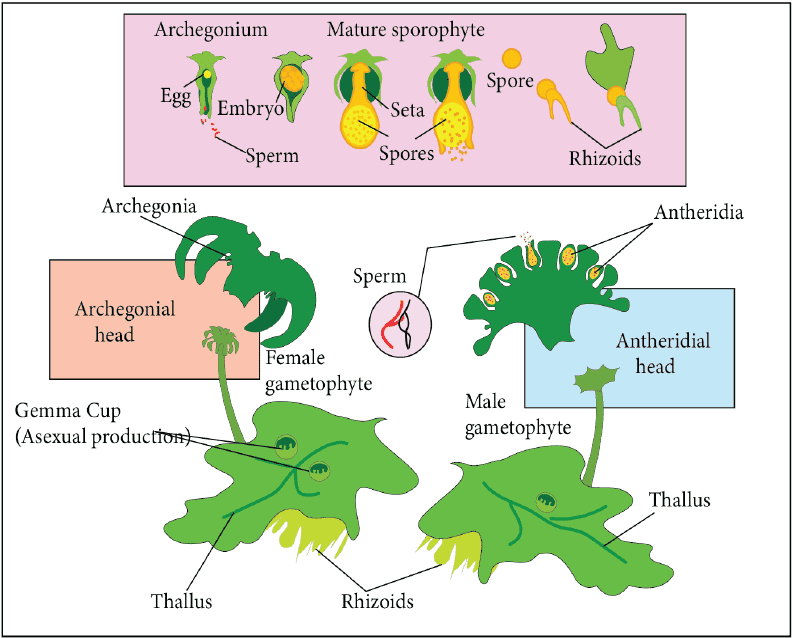
Life Cycle of Marchantia (A Dioecious Liverwort)
Male plants have an antheridial head that can produce sperm. A female archegonial head lays an egg.
Sperm are spread from male gametophytes and brought by water or wind to the egg on another plant.
When the sperm fertilises the egg, an embryo is formed, which then develops into a sporophyte.
Riccia and Marchantia are the two most popular examples of liverworts.
Mosses:
The most important phase in a moss' life cycle is the gametophyte, which comprises two stages.
The protonema stage develops directly from a spore.
As a leafy stage, a lateral bud emerges from the secondary protonema.
Multicellular and branched rhizoids are found in them which connect them to the soil.
Mosses reproduce vegetatively through secondary protonema fragmentation and budding.
In sexual reproduction, the sex organs antheridia and archegonia produce a zygote, which arises into a sporophyte having a foot, seta, and capsule.
Funaria and Polytrichid are two examples of mosses.
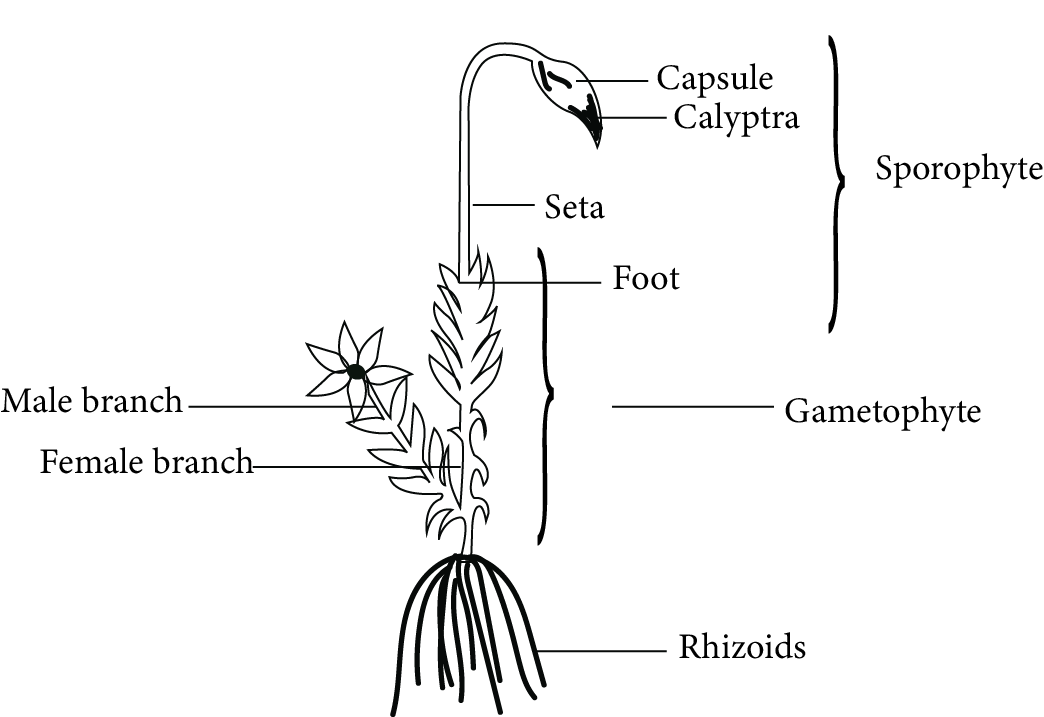
Funaria (A Moss)
Economic Importance of Bryophytes:
1. Ecological Importance:
Pioneer of Land plants: Bryophytes are land plant pioneers because they were the first plants to grow and colonise barren rocks and lands.
Prevention of Soil Erosion: Bryophytes keep soil from eroding. They typically grow densely and thus serve as soil binders. Mosses form dense strands that form a mat or carpet-like structure.
2. Peat Formation:
Peat is a brown or dark-colored substance made in bogs by the slow but steady compression and carbonization of partially decomposed parts of dead vegetative matter.
Sphagnum is an aquatic moss that when dies, is converted into peat. As a result, Sphagnum is also known as peat moss.
Peat has been used to make fuel, surgical dressings, horticulture, and other products.
3. As a Packing Material: Dried mosses have a high water retention capacity. They are used as packing material for the shipment of flowers, fruits, vegetables, and other items because of this ability.
4. As Bedding Stock: Because of their ability to hold and absorb water, thalli of Bryophytes are used to cover beds in nurseries.
5. In Medicine: A few bryophytes are used medicinally in a variety of diseases, including
Pulmonary tuberculosis and liver affliction - Marchantia
Acute haemorrhage and eye diseases - Sphagnum decoction
Kidney and gallbladder stone - Polytrichum commune.
Antiseptic properties and aid in wound healing - Sphagnum leaves
6. In Experimental Botany: Liverworts and mosses are important research tools in many fields of botany, including Genetics. The process of sex determination in plants was observed for the first time in a liverwort, Sphaerocarpos.
7. As Food: Some bryophytes, such as mosses, are consumed by chicks, birds, and Alaskan reindeer.
Pteridophytes
Pteridophytes prefer cool, moist, shady conditions.
The diploid sporophyte is the dominant generation in their life cycle.
Zygote or fertilised egg undergoes mitotic division, forming various segments like roots, stem, sporophyte, and later spores, which are formed through meiosis and dispersed, and thus the cycle continues. In pteridophytes, the dominant phase is thus sporophyte.
A sporophyte has not only real stems, roots, and leaves but also well-differentiated vascular structures.
Pteridophytes are the earliest vascular plants, with a simple reproductive system that lacks flowers and seed.
Pteridophytes developed a vascular system of xylem and phloem to transport fluids, allowing them to reach greater heights than their avascular ancestors.
Sporophylls are leaf-like appendages that can constitute unique compact cell bodies called strobili or cones which protect sporangia in sporophytes.
By meiosis, the sporangia inside the capsule of sporophyte produce spores from the spore mother cells. These spores germinate and develop to create thalloid gametophytes.
Gametophytes have male and female sex organs called antheridia and archegonia.
Water is required for the transport of antherozoids to the mouth of the archegonium, and the fusion of the male gamete and female egg together in the archegonium leads to the formation of a zygote.
The zygote produces a well-differentiated, multicellular sporophyte, which is the dominant phase of pteridophytes.
Homosporous plants like Psilotum, Lycopodium, Equisetum, etc make homosporous spores i.e. both sexes produce spores of the same kind.
However, both sexes of heterosporous plants release dissimilar spores, like micro and macrospores. Micro and macrospores are produced by Selaginella and Salvinia. Female gametophytes are in charge of transforming zygotes into young embryos.
Pteridophytes exhibit alternation of generations. Their life cycle is similar to that of seed-bearing plants, but they differ from mosses and seed plants in that both haploid gametophyte and diploid sporophyte generations are free-living and independent.
Pteridophytes are further classified into four types:
Classes of Pteridophytes | Characteristics | Examples | Diagrams |
Psilopsida | 1. They include the most primitive Pteridophytes. 2. The photosynthetic stem is dichotomously branched. 3. Rhizoids can be found. 4. Most of them lack leaves. 5. The sporophyte is of homosporous type. | Psilotum, Tmesipteris | 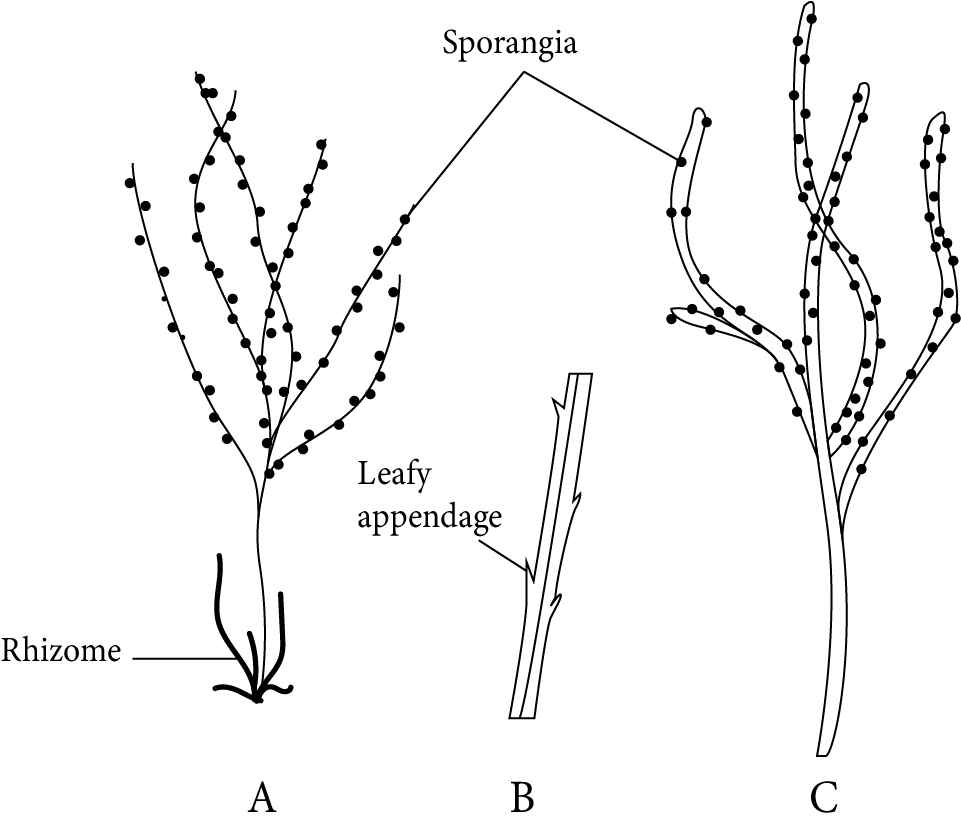
Psilotum Nudum |
Lycopsida | 1. They are commonly referred to as club moss. 2. Plant body is well-differentiated, with adventitious roots, stems, rhizophores, and leaves. 3. The sporophyte can be either homosporous (Lycopodium) or heterosporous (Selaginella). | Selaginella, Lycopodium | 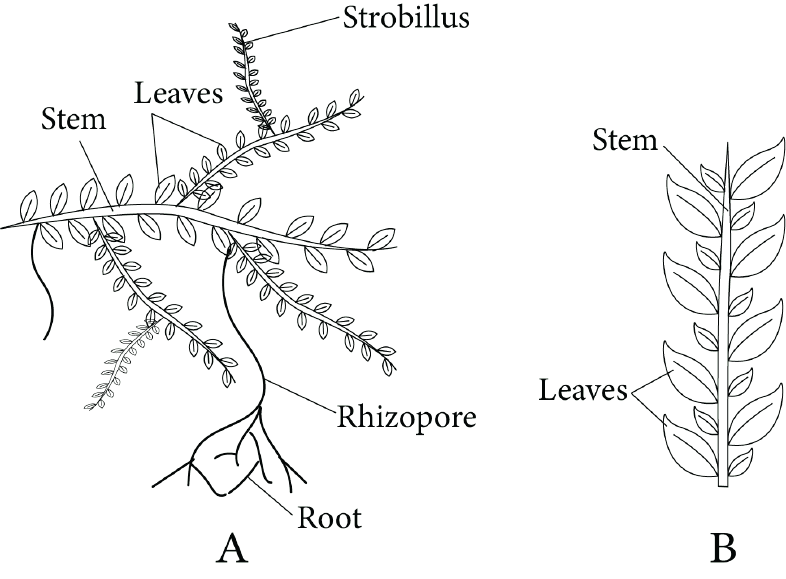
Selaginella |
Sphenopsida | 1. Also known as Horsetail. 2. Plant body with well-differentiated roots emerging from underground rhizome nodes, stem, as well as scaly leaves. 3. Sporangia are homosporous and are born on strobili. | Equisetum | 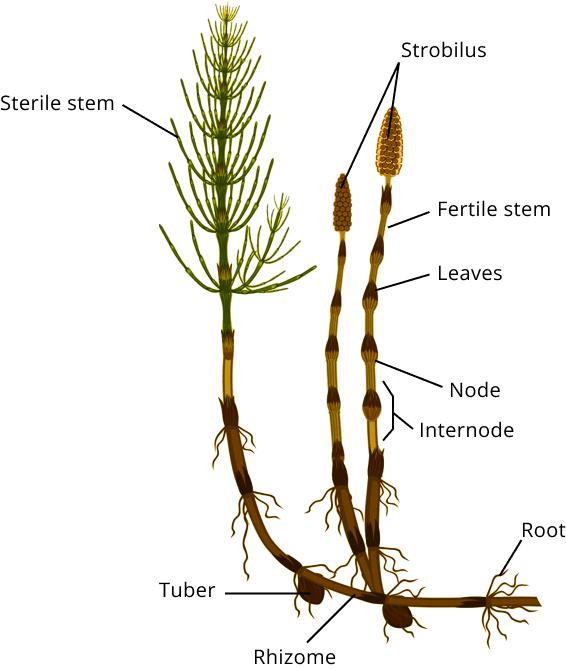
Equisetum |
Pteropsida | 1. Also referred to as a fern. 2. Plant body with distinct roots, stem, and leaves. 3. The sporophyte can be either homosporous (Adiantum) or heterosporous (Dryopteris). 4. Antherozoids are multi-flagellated in these organisms. | Dryopteris, Pteris, Adiantum | 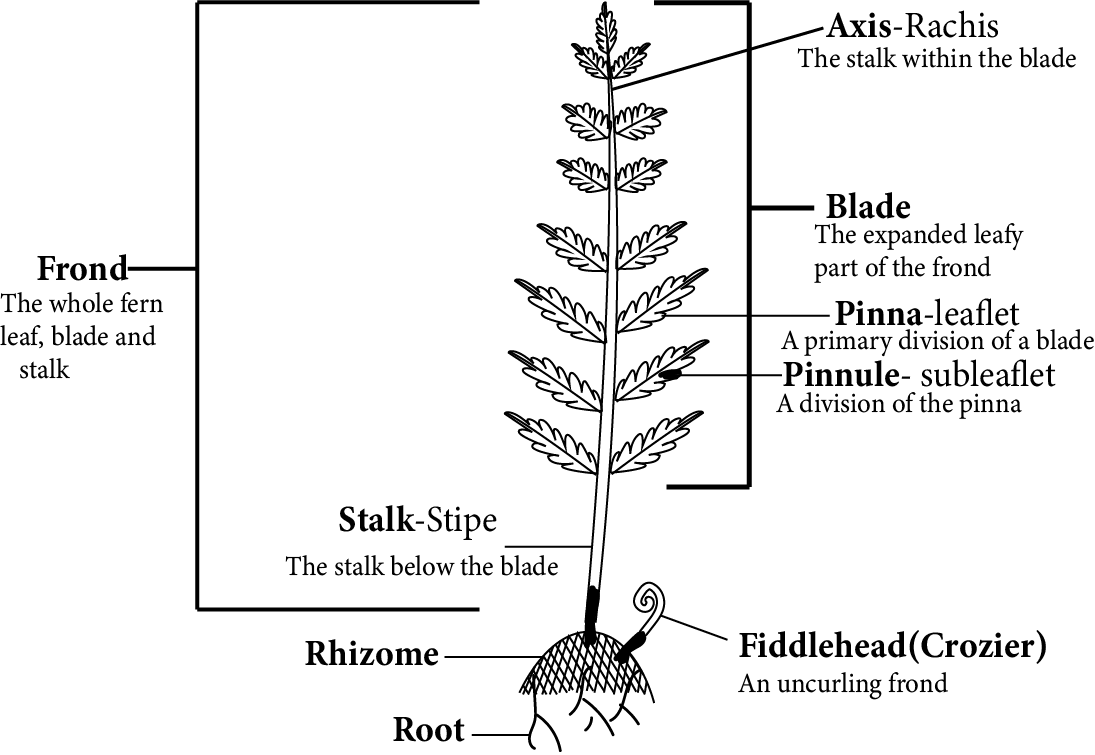
Dryopteris |
Economic Importance of Pteridophytes:
(1) Food: Pteridophytes, like other plants, provide a good food source for animals. Marsilea, a water fern, produces starch which is cooked and consumed by certain tribes.
(2) Soil Binding: Pteridophytes, through their growth, bind the soil even along steep hills. The soil is kept from eroding.
(3) Scouring: Equisetum stems were used for scouring (cleaning utensils) and metal polishing. Equisetum species are thus also known as scouring rushes.
(4) Nitrogen Fixation: The water fern Azolla has a symbiotic relationship with the nitrogen-fixing cyanobacterium Anabaena azollae. It is injected into paddy fields to act as a biofertilizer.
(5) Medicines: Dryopteris rhizomes are used to make an anthelmintic drug (Male Shield Fern).
(6) Ornamentals: Ferns are cultivated for their delicate and beautiful leaves, thus they also have ornamental value.
Gymnosperms
Gymnosperms are plants forming exposed ovules which are the ovules not enclosed by an ovary wall.
Gymnosperms include the massive redwood tree Sequoia, one of the tallest trees on the planet.
The roots are primarily tap roots (e.g., Pinus) with fungal associations and this symbiotic interaction is called the mycorrhiza. However, the small specialised roots known as coralloid roots (e.g., Cycas) house N2-fixing cyanobacteria in them.
Plants like Cycas have unbranched stems.
Simple or compound leaves include pinnate leaflets in Cycas as well as needle-like leaves in conifers like Pinus.
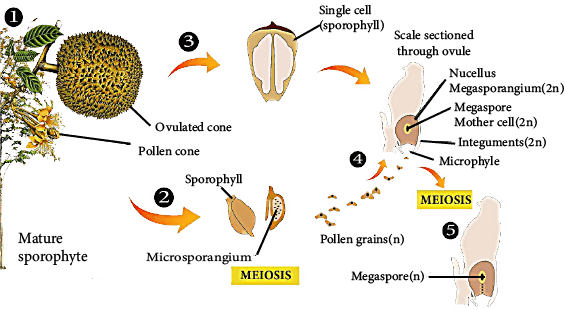
Image: Life cycle of Gymnosperms
Gymnosperms are heterosporous, forming compact strobila or cones from sporangia on sporophylls organised spirally along an axis to produce haploid microspores and megaspores.
Microsporangia, also known as male strobili, are strobili containing microsporophyll and male gametophytes.
Microspores of microsporangia develop into pollen grains, which are highly reduced male gametophytes.
Macrosporangia, also known as female strobili, are cones that contain megasporophylls as well as ovules or megasporangia.
The megaspore mother cell is differentiated from one of the nucellus cells, leading to the formation of an ovule.
The mother cell of the megaspore divides meiotically to give rise to four megaspores, one of which grows and develops into a multicellular female gametophyte carrying two or more archegonia (female sex organ) which are enveloped within the megasporangium (nucellus).
Male and female gametophytes, and also pollen grains, are released into the air and come into contact with the opening of megasporophyll-carried ovules.
The pollen tube enclosing the male gametes develops and enters the ovules and then releases its contents close to the archegonia's mouth for fertilisation, leading to the production of zygotes and, eventually, uncovered seeds.
Gymnosperms have a diplontic life cycle, with the sporophytic phase being the dominant phase. Meiosis takes place in the diploid spore mother cells and results in gametophyte formation. The gametophytic phase is depicted by haploid gametophytes, which are short-lived and reliant on the photosynthetic sporophyte.
Economic Importance of Gymnosperms:
Some Cycas species, such as Cycas revoluta and Cycas rumphii, resemble palm trees and are preferred for decoration because they stay fresh for a long time.
The stem part of Cycas revoluta is a great source of 'sago' which is a type of starch used by poor people to make bread. Some Cycas species' seeds are roasted and eaten as food. Some Cycas species' young succulent leaves are cooked as a vegetable.
Many gymnosperms have medicinal properties. Fresh juice extracted from Cycas circinalis leaves is used in the treatment of stomach disorders, blood vomiting, and some skin diseases. Some Cycas plants' pollen grains have been reported to have narcotic properties.
Some gymnosperms, such as Pinus, Abies, and Cedrus, are the primary source of different wood types. Juniperus wood is used to make pencils, scales, holders, and other items.
Some Pinus species are good sources of turpentine, wood gas, and wood alcohol.
Angiosperms
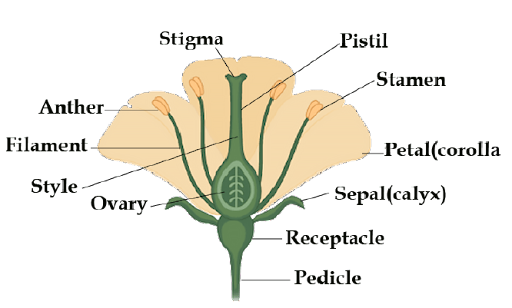
Angiosperm
Angiosperms, commonly called flower-producing plants, create pollen grains and ovules in specialised structures called flowers, while fruits contain seeds.
They have been divided into two groups, Dicots and Monocots.
The existence of two cotyledons in the seeds distinguishes dicotyledons from the angiosperms having one cotyledon in their seeds, known as monocotyledons.
The stamen is a male sex organ in a flower made up of a short filament to which an anther is attached at the tip. The anthers yield pollen grains after meiosis.
The female sex organ formed in a flower is called the pistil or carpel, which consists of an ovary surrounding one or many ovules.
Embryo sacs contain significantly fewer female gametophytes than ovules.
Meiosis occurs before the formation of the embryo sac.
Each embryo sac has a three-celled egg apparatus made up of one egg cell, two synergids, and three antipodal cells with two polar nuclei that eventually combine to create a diploid secondary nucleus.
Pollen grains are released from the anthers and then transferred to the stigma of a pistil along with wind or other agents during pollination.
The pollen grain germinates on the stigma and the resulting pollen tube grows through the tissues of stigma and style and reaches the ovule. The pollen tube enters the embryo sac through the micropylar end and discharges the two male gametes present in the pollen grain. One of the male gametes fuses with the egg cell to form the zygote. This is known as syngamy. The other male gamete fuses with the diploid secondary nucleus to produce the triploid primary endosperm nucleus (PEN). Thus, double fertilisation occurs, an event unique to angiosperms.
After fertilisation the synergids and antipodal cells degenerate. The zygote develops into an embryo and the primary endosperm nucleus (PEN) develops into an endosperm which provides nourishment to the developing embryo. The synergids and antipodals degenerate after fertilisation.
Following fertilisation, the synergids and antipodal cells degenerate, however, the ovules and ovaries mature into seeds and fruit, respectively.
Plant Life Cycles:
There are various kinds of plant life cycles because different plants have varying levels of complexity. This is why different generations of plants predominate.
Algae exhibit the haplontic life cycle, where the sporophyte generation is indicated by a single-celled zygote that is not free-living.
The gametophyte in this type of life cycle is the dominant phase.
The diplontic life cycle is observed in angiosperms and gymnosperms with a few modifications. The dominant diploid sporophyte in this life cycle is photosynthetic and represents the plant's autonomous stage.
The gametophyte phase is indicated by a single to many haploid gametophytes.
Pteridophytes and bryophytes have a multicellular stage in their life cycle known as the haplo-diplontic life cycle. The dominant stage, on the other hand, varies.
In Bryophytes, the gametophyte phase is dominant, whereas, in Pteridophytes, the sporophyte phase is dominant.
Generational Transition:
Plants exhibit two different kinds of reproduction systems, each known as a generation. As a result, two generations alternate in one full life cycle. As a result, it is referred to as generational alternation.
The sporophyte and gametophyte generations are a cycle of haploid and diploid stages that are linked by chromosomes in plant cells.
A diploid cell contains two sets of chromosomes, but a haploid cell contains only one pair.
The haploid generation produces plants with diploid cells, which generates another generation of haploid plants, which generates again another generation of diploid plants, and the cycle repeats.
The haploid stage eradicates bad genes, whereas the diploid stage promotes genetic diversity.
Key Points to Remember
Plant kingdom includes algae, bryophytes, pteridophytes, gymnosperms and angiosperms.
Algae are photosynthetic thalloid and largely aquatic organisms.
Algae are classified into three classes depending on the type of pigment present in them and type of stored food.
The three classes are namely Chlorophyceae, Phaeophyceae and Rhodophyceae.
Algae usually reproduce vegetatively by fragmentation, asexually by spore formation and sexually by gamete formation.
In algae sexual reproduction may show isogamy, anisogamy or oogamy.
Bryophytes are known as the amphibians of the plant kingdom. Their body is thallus-like and prostrate or erect and attached to the substratum by rhizoids.
They possess root-like, leaf-like and stem-like structures.
Bryophytes are divided into liverworts and mosses.
The main plant body of a bryophyte is haploid and is called a gametophyte.
The gametophyte bears male and female sex organs - the antheridia and archegonia respectively-
The male and female gametes fuse to form the diploid multicellular body called sporophyte.
Sporophyte produces haploid spores which on germination give rise to haploid gametophytes.
In pteridophytes the main plant is a sporophyte which is differentiated into true root, stem and leaves.
They are the first terrestrial plants to possess the vascular tissues.
The sporophytes bear sporangia which produce the haploid spores.
The spores germinate to form gametophytes which require cool, damp places to grow.
The gametophytes bear antheridia and archegonia.
Water is required for transfer of male gametes to archegonium where zygote is formed after fertilisation.
The zygote develops into a sporophyte.
The gymnosperms are plants which have naked seeds not enclosed by fruit.
The gymnosperms produce microspores and megaspores which are produced in microsporangia and megasporangia born on special leaf-like structures called sporophylls.
The sporophylls are usually aggregated to form cones or compact strobili or lax.
The cones bearing microsporophylls are known as male strobili and cones which bear macrosporophylls are known as female strobili.
After pollination, pollen grain germinates and a pollen tube releases the male gamete into the ovule, where it fuses with the egg cell in archegonia.
The zygote develops into embryos and the ovules into seeds.
In angiosperms, flower contains the male sex organs (stamen) and the female sex organs (pistil).
Stamen consists of a filament and anther. The male gametophytes
The pistil consists of an ovary enclosing one to many ovules. Ovule contains the female gametophyte or the embryo sac containing the egg cell.
The pollen tube after entering the embryo sac releases two male gametes. One male gamete fuses with egg cell and other fuses with diploid secondary nucleus. Double fertilisation occurs.
There is alternation of generation during the life cycle of sexually-reproducing plants. The different life cycle patterns are haplontic, diplontic or haplo-diplontic.
Importance of NEET Advanced Plant Kingdom Class 11 Notes
The Plant Kingdom in Class 11 notes covers different aspects of plants. It is defined as a multicellular, eukaryotic living entity with the chlorophyll in its cell walls, which gives plants their green hue. The plant kingdom is classified into two categories: Crytogame and Phanerogamae. It further defines Algae which includes the simplest form of plants posing undifferentiated reproductive organs called the Gametangia. The chapter further discusses that diverse plant groups have different patterns for completing their life cycles. For example, angiosperms have two stages in their life cycle: diploid sporophytes and haploid gametophytes.
Using the study note, you can further learn about the plant kingdom and the chemical aspects concerning it. Moreover, you will find out about the classification of Angiosperms. You can use these notes for the preparation of NEET exam. The main aim of using notes is to clear the subject's concept and foundation in all forms.
Benefits of Plant Kingdom Class 11 Notes
The subject experts of Vedantu elaborated on different areas of the plant kingdom and its classification in Plant Kingdom Class 11 notes. Every area of the chemical substance from plants is explained properly and step-by-step.
You can understand and learn about the different Algae types, including Green Algae, Brown Algae, and Red Algae through a comprehensive reading of these notes.
Solve the problems relating to these concepts to prepare for the NEET exam test. Follow the instructions in the revision notes to learn about different classifications. Clear your concerns and learn the characters and life cycle of plant chemicals.
The revision notes allow you to review the entire chapter quickly. Also, it might not be possible to revise the entire chapters during the las-minute revision, therefore, using these revision notes will help you to brush up on all the important concepts of the chapter.
Download Plant Kingdom Class 11 Notes for NEET PDF
You can now download the complete Plant Kingdom Class 11 Notes for NEET PDF. Learn the concepts in and out whenever you want during the NEET exam preparation. Find the difference and chemical aspects of plants. Using the Plant Kingdom Class 11 notes PDF will help the students during their last-minute revision. Students will get the Plant Kingdom notes PDF download option at Vedantu to prepare anytime, anywhere, as a part of their study and revision.
NEET Biology Revision Notes -Chapter Pages
NEET Biology Chapter-wise Revision Notes | |
Plant Kingdom Notes | |
Other Important Links
Other Important Links for NEET Plant Kingdom |
FAQs on Plant Kingdom NEET Notes 2024
1. What are Algae and what are their characteristics?
Algae are the simplest form of plants, which have undifferentiated or thallus-like morphologies, as well as single-celled reproductive organs known as gametangia. It solely contains algae.
The characteristics of algae include the following:
The thallus, which can be unicellular, filamentous, colonial, or parenchymatous, is the plant's main body.
The majority of them are aquatic, although a few can also be found in damp terrestrial habitats such as tree trunks, wet rocks, moist soil, and so on.
There are no vascular or mechanical tissues.
2. What are plant alternations of generation?
Diverse plant groups have different patterns for completing their overall life cycles. Angiosperms have two stages in their life cycle: diploid sporophytes and haploid gametophytes. Both follow each other. Alternation of generation is the term for this phenomenon.
Only the one-celled zygote represents the Haplontic- Saprophytic generation. In a zygote, meiosis produces haploid spores, which generate gametophytes, the dominant vegetative phase. Volvox, Spirogyra, and other similar species are examples.
Diploid sporophytes are dominating, self-contained photosynthetic plants. Single to few celled gametophytes are depicted. This category includes all seed-bearing plants.
3. What are the three types of reproduction?
Vegetative, asexual, and sexual reproduction are the three types of reproduction. Asexual reproduction is accomplished through the generation of many types of spores, the most common of which are zoospores. Fragmentation is the mode of vegetative reproduction. The fusing of two gametes results in sexual reproduction. These gametes can be flagellated and of similar size or non-flagellated but of similar size. Isogamous reproduction refers to this type of reproduction.
4. What are the different types of algae?
There different types of algae include Euglenophyta (Euglenoids), Chrysophyta (Golden-brown algae and Diatoms), Pyrrophyta (Fire algae), Chlorophyta (Green algae), and Rhodophyta (Red algae).








 Watch Video
Watch Video


